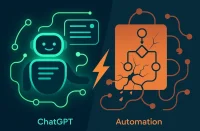10 ways AI beats you at coding might sound controversial, but regardless of your opinion on LLMs and AI, there are undeniable use cases where AI is simply faster and more efficient than doing it yourself. Whether you love or hate AI, these examples demonstrate where LLMs excel and can significantly boost your productivity as a developer.
The reality is that developers who code well AND have figured out how to properly incorporate LLMs into their workflows are not only more productive—they’re setting themselves up for a future where this is becoming the norm. The key distinction is between developers who can code well and use AI as a tool versus those who rely solely on AI without understanding the underlying concepts.
The Developer Hierarchy in the AI Era
This becomes clear when you understand the new developer hierarchy. The most valuable developers are those who can code well without AI but choose to use AI for efficiency. This is greater than those who can code well but don’t use AI, which is greater than those who cannot code but can use AI.
This hierarchy matters because if you lose your job and re-enter the job market, it’s a very different place now. Developers who have mastered both coding fundamentals and AI integration are positioning themselves for long-term success in an increasingly AI-driven industry.
The key is using AI to become more efficient in what you can already do, not relying on it to build things you don’t understand. This distinction separates productive AI usage from dependency.
1. Regex Generation and Explanation
The first advantage starts with regex generation. You should be 100% done looking up regex patterns manually. An LLM can write and explain regex for you on the spot.
Example: Write a regular expression that matches a US phone number in these formats: (555) 123-4567, 555-123-4567, 555.123.4567, 5551234567, and create a TypeScript function called matchesUSPhoneNumber that returns a boolean. Then explain how the regex works, breaking it down by each component.
Not only do you get your code instantly, but you also get a detailed explanation of how it works. This saves hours of research and trial-and-error debugging.
2. Generating Unit Tests
The second advantage includes automated test generation. Creating comprehensive unit tests can be time-consuming and tedious, but AI excels at this task.
Example: Write unit tests for this function, covering normal, edge, and error cases. Simply paste your function into the LLM, and you’ll get:
- Normal test cases
- Error handling tests
- Edge case scenarios
- All written in seconds
This ensures your code is properly tested without the manual effort of writing each test case individually.
Smarter Testing with AI
Automated unit test generation saves time and ensures reliable code quality. Employers can gain efficiency by hiring developers skilled at leveraging AI to cover normal, error, and edge cases in seconds. Post your job on WhatJobs today and connect with tech talent ready to deliver faster, cleaner, and more dependable code.
Post a Job Free for 30 Days →3. Summarizing Pull Requests and Change Logs
The third advantage extends to code review and documentation. Got a 50-file pull request? Let the LLM break it down for you and extract the high-level what and why in seconds.
Example: Use a git diff command to capture changes, then prompt the LLM: “See the pull request diff in pr.txt. Give me a summary of the overall changes, why they were made, and an explanation of each file change, what was modified, and for what purpose.”
This doesn’t replace proper code review, but it gives you instant context and a breakdown as a starting point, saving significant time on large changesets.
4. Writing Complex SQL Queries
The fourth advantage includes SQL query generation. Describing what you want in English is often faster than manually writing complex multi-join SQL queries.
Example: Write a SQL query that finds the top 10 products by revenue, but only for customers in California who placed an order in the last 90 days. Use the schema defined in Prisma/schema.prisma.
The LLM generates complex queries much faster than writing from scratch, especially when working with messy schemas, reporting requests, or business logic that’s easier to describe than to write.
5. Converting Config Files Between Formats
The fifth advantage includes file format conversions. LLMs excel at converting files from JSON to YAML, JSON to TOML, or any other format conversion.
Example: Convert this JSON configuration to TOML format for our new project. The conversion happens in seconds, eliminating manual work and potential errors.
This is particularly useful when migrating between different tools or frameworks that use different configuration formats.
6. Breaking Out Files into Other Formats
The sixth advantage includes complex file transformations. Need to convert a Docker Compose file to Kubernetes manifests? This can take an hour manually but seconds with AI.
Example: Convert this docker-compose.yaml file into Kubernetes manifests, preserving all environment variables and ports. The LLM breaks out individual manifests for deployment to Kubernetes.
This saves significant time when migrating between different deployment platforms or container orchestration systems.
7. Writing Boilerplate Code
The seventh advantage includes generating boilerplate code for API handlers, CRUD endpoints, config files, and scripts.
Example 1: Write a batch script that checks if certain websites are up every 5 minutes, logs results to status.log, and sends a desktop notification if it fails more than three times in a row.
Example 2: Make a bash script that stops all running Docker containers, removes unused volumes, and prunes dangling images, asking for confirmation before deleting.
Example 3: Convert this Terraform module to a CloudFormation template.
These tasks are tedious and time-consuming when done manually but can be completed in seconds with AI assistance.
8. Documenting and Explaining Codebases
The eighth advantage includes codebase documentation. Analyzing and documenting complex applications can take hours or days manually.
Example: Look through this application and summarize the architecture and flow, also creating a directory map. The LLM analyzes all files, summarizes the architecture, and creates a comprehensive directory map.
If you’re using Cursor, you can use /init to create a README.md file with all this information automatically.
9. Security, Performance, and Best Practice Review
The ninth advantage includes comprehensive code reviews. AI can perform thorough reviews focusing on security, performance, and best practices.
Example: Please perform a high-level review of my codebase focusing on:
- Security: Look for common vulnerabilities and provide examples
- Performance: Identify inefficient code and unnecessary computations
- Best practices: Check adherence to language and framework conventions
Provide actionable recommendations and highlight critical issues that should be addressed first, including examples or improved code snippets.
This is particularly valuable for personal projects where you might not have access to senior developers for code reviews.
10. Answering “Stupid” Questions
The tenth advantage includes providing a safe space for questions you might be hesitant to ask colleagues. As software developers, we often have questions we want answered but never ask for fear of looking inexperienced.
Example: Explain concepts before working on them. If you have a PR with nested iteration and need to improve efficiency from quadratic time complexity, you can copy and paste the code to an LLM and get an explanation of the problem and what needs to be improved.
This allows you to:
- Ask questions without judgment
- Get explanations of complex concepts
- Explore different approaches
- Learn without exposing knowledge gaps to colleagues
Additional AI Use Cases
These advantages extend beyond these examples. AI excels at:
- Explaining error messages and stack traces
- Generating dummy data and seeding databases
- Summarizing documentation
- Creating boilerplate code for various frameworks
- Auto-suggesting code completions
- Refactoring and code optimization
The key is recognizing that AI is most effective for tedious, repetitive, or time-consuming tasks that don’t require deep creative thinking.
The Future of Development
These examples point to a future where developers who embrace AI as a tool will have significant advantages. If it takes you 20 minutes to complete a task that takes an AI-assisted developer 5 seconds, and both achieve the same result, the AI-assisted developer has a clear advantage.
This doesn’t mean AI will replace developers, but it does mean that developers who learn to work effectively with AI will be more productive, efficient, and valuable in the marketplace.
Build the Future with AI-Assisted Developers
The future belongs to developers who embrace AI as a productivity tool. Employers can gain a competitive edge by hiring talent that knows how to code faster, smarter, and more efficiently with AI. Post your job on WhatJobs today and connect with developers ready to shape the next era of technology.
Post a Job Free for 30 Days →Frequently Asked Questions
Should I rely on AI for all my coding tasks?
These examples don’t mean you should rely on AI for everything. Use AI for tedious, repetitive, or time-consuming tasks while maintaining your core coding skills. The goal is to become more efficient, not dependent.
How do I know if I’m using AI effectively?
These examples show effective AI usage when you’re using it to enhance your existing skills rather than replace them. You should understand the code AI generates and be able to modify or debug it when needed.
What if the AI generates incorrect code?
These examples include the responsibility to test and validate AI-generated code. Always review, test, and understand the code before using it in production. AI is a tool, not a replacement for good judgment.
How do I get started with AI-assisted coding?
These examples suggest starting with simple tasks like regex generation, unit test creation, or documentation. Begin with tasks you understand well, then gradually expand to more complex use cases as you become comfortable with the tools.
A Real-World Example: David’s Productivity Transformation
David Kim, a 32-year-old full-stack developer from Austin, exemplifies how these AI advantages can transform your development workflow. After initially resisting AI tools, David began incorporating them into his daily work.
“I was skeptical at first, but the regex generation alone saved me hours every week,” David explains. “I used to spend 30 minutes looking up regex patterns and testing them. Now I get the exact pattern I need in seconds, with a full explanation.”
David’s biggest breakthrough came with unit test generation. “I was terrible at writing comprehensive tests, but AI generates them perfectly. I just paste my function and get complete test coverage in seconds. My code quality has improved dramatically.”
The most valuable use case for David was code review assistance. “I work on a small team without senior developers, so getting AI to review my code for security issues and best practices has been invaluable. It catches things I would never think to look for.”
David’s productivity has increased by an estimated 40% since incorporating AI into his workflow, and he’s become the go-to developer for complex tasks on his team.
These examples represent a fundamental shift in how we approach development work. They demonstrate that AI isn’t about replacing developers—it’s about making them more efficient and productive. The developers who embrace AI as a powerful tool while maintaining their core coding skills will be the ones who thrive in the future of software development.




